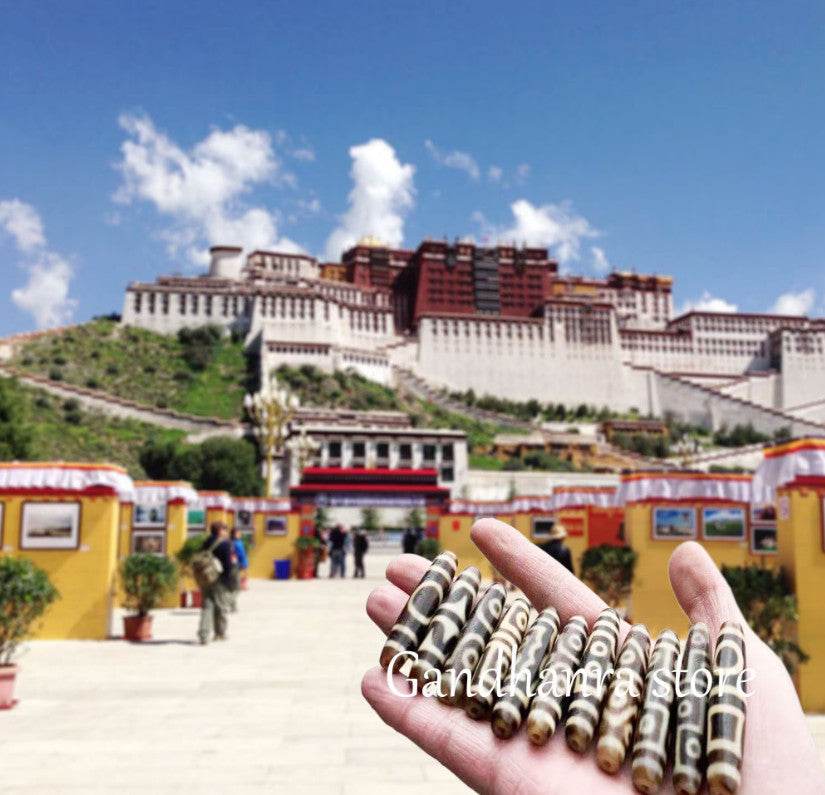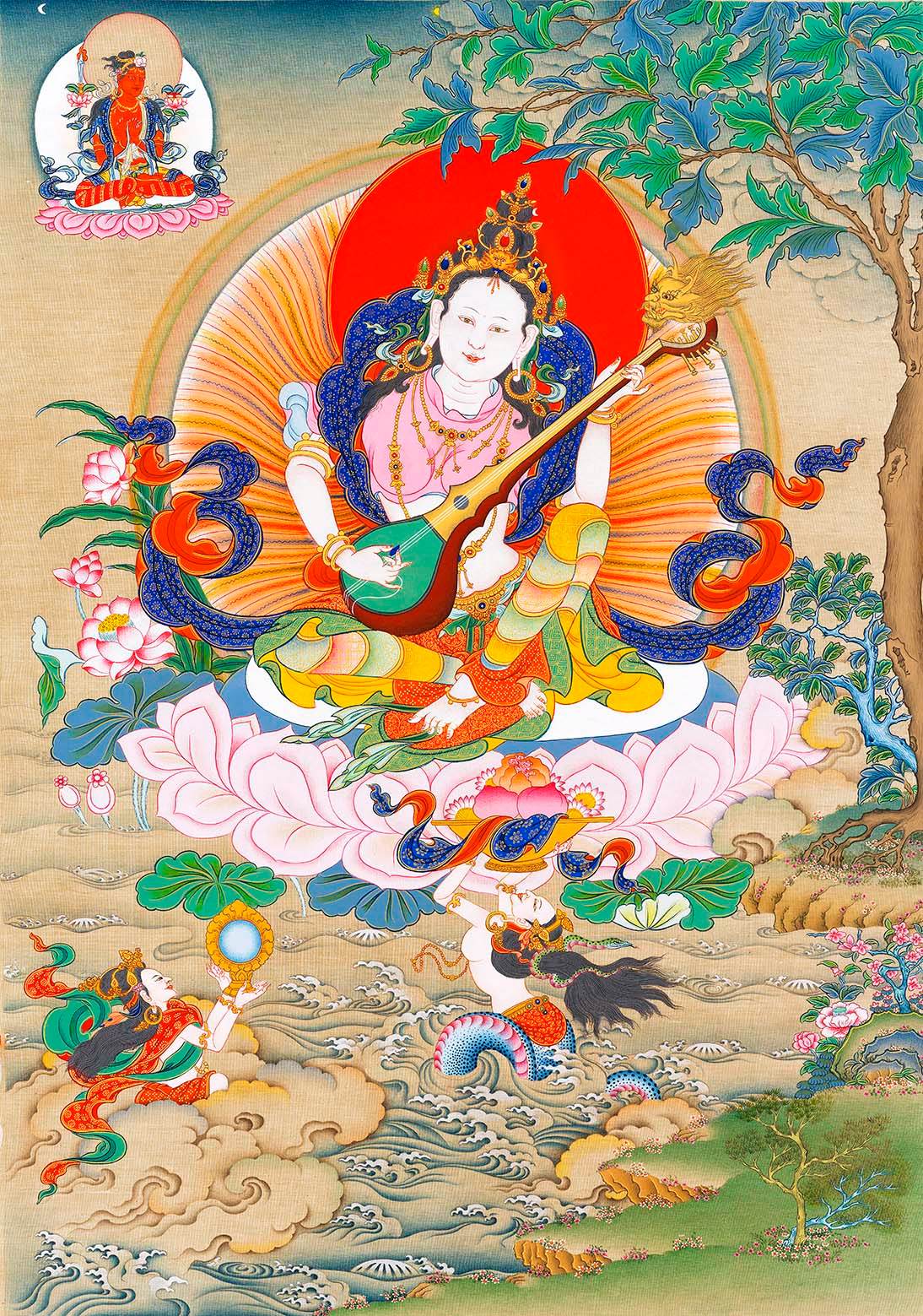
Tibetan Radish in Harry Potter

Zagali: The Four-Armed Ganesha
Early 20th century, private collection
མགོ་ནི་གཡུ་ཡི་རལ་པ་ཅན།
སྐེད་པ་དུང་གི་འཁོར་ལོ་ཅན།
རྔ་མ་སྦྲུལ་གྱི་རྔ་མ་ཅན།
Head adorned with turquoise hair,
Waist like a conch shell's spiral,
Tail ends in a snake's tail.
Riddle answer: Radish (ལ་ཕུག་)

Partial view of the above image: Holding a white radish
ལ་ཕུག་འདྲ་ཡང་ལ་ཕུག་མིན།
ཟས་མཆོག་སྨན་མཆོག་ཡོངས་སུ་གྲགས།
Looks like a radish but isn't a radish,
Renowned for being good to eat and good as medicine.
Riddle answer: Turnip (ཉུང་མ་)

"Blue Beryl Medical Thangka: Dietary Guidelines"
Early 20th century, Lhasa Men-Tsee-Khang
Partial: Turnip
Its juice is used as a cooking ingredient
(Turnips also have young and old distinctions with the same method of differentiation)
Starting from Harry Potter
In the wizarding world of Harry Potter, the Pan-Himalayan region does not appear very frequently. *Fantastic Beasts: The Secrets of Dumbledore* (2022) set the location for the election of the next supreme leader of the wizarding world in Bhutan, which sparked widespread discussion at the time. Beyond this, in various works describing the world's lore, there are still a few details mentioning the Pan-Himalayan region. Firstly, there are the Yeti that live here. Because their whereabouts are difficult to pinpoint and they can potentially cause harm, there are specialized wizarding personnel constantly monitoring their activities.

Secondly, in the 1926 issue of *Transfiguration Today*, the newspaper published an interview with the "Tibetan Oracle," who was believed to possess powerful magic. Finally, in the film *Harry Potter and the Goblet of Fire*, when Harry and Neville are discussing how to approach the second task, a possibly non-existent magical plant is mentioned. In most cases, this plant is translated as "Tibetan radish"; however, based on the original text, it should be translated as "Tibetan turnip." Turnips play an important role in daily life in Tibet.
 *Transfiguration Today* mentions the "Tibetan Oracle"
*Transfiguration Today* mentions the "Tibetan Oracle" From the film *Fantastic Beasts and Where to Find Them* (2016)

"A Bamboo Basket Filled with Dried Turnip Leaves"
2016, photographed by Lhakpa
"Even if meat, butter, and pastries are not all available, turnip soup is never lacking at any of the three meals."
There are over forty methods of preparing turnips in Tibet (with slight regional variations). The unique climatic and geographical conditions of Tibet made turnips, which "satiate hunger even in lean years," a beloved staple among the ancestors. Similar to nettles, turnip soup was regarded by sages as a symbol of determination in spiritual practice and doctrinal principles. For instance, Butön's disciple Dractepa Rinchen Namgyal (སྒྲ་ཚད་པ་རིན་ཆེན་རྣམ་རྒྱལ་;1318–1388) used turnip soup to impart teachings to his disciples. In Bhutan, legends still circulate of Thangtong Gyalpo using supernatural powers to manifest turnips to feed victims during a famine.

"Blue Beryl Medical Thangka: Dietary Guidelines"
Early 20th century, Lhasa Men-Tsee-Khang
Partial: Young Radish and Old Radish
Young Radish: Radish harvested before the appearance of the Rishi star
Old Radish: Radish that has been stored for a long time or harvested after the appearance of the Rishi star
*The Rishi star is associated with the "Tibetan Bathing Festival"
Although radishes and turnips both belong to the Brassicaceae family, they fall under different genera. In Tibetan, the radish is called ལ་ཕུག་, a term derived from the Chinese word for radish. The carrot, which belongs to the Apiaceae family rather than Brassicaceae, is referred to as གུང་ལ་ཕུག་. Most modern scholars interpret the element གུང་ in this term as meaning "foreign" or "red." However, sinologist Berthold Laufer (1874–1934), in his analysis of the term's etymology and phonetic evolution, concluded that "it is difficult to understand it as 'foreign' or 'red'."
In the *Qianlong Pentaglot Dictionary*, the carrot is named ལ་ཕུག་མངར་པོ་ (sweet radish), while in Tibetan dialects, it is also known as ལ་ཕུག་སེར་པོ་ or ལབ་སེར་ (yellow radish).
The German missionary and Tibetologist H.A. Jäschke (1817–1883) included the term གུང་དམར་ལ་ཕུག་ in his *Tibetan-English Dictionary*, noting that it was used by people in Western Tibet and merchants from the Ü-Tsang region. Here, the debated element གུང་ is combined with དམར་, meaning "red." Some scholars have linked གུང་ to the Chinese title "公" (gong), suggesting it refers to radishes grown in Chinese vegetable gardens managed under the supervision of the Amban in Tibet. Additionally, in Western Tibet, the term སེ་རག་དུར་སྨན་ is used for carrot, believed to derive from the Persian term *Zardak turma*.

Manuscript of the "Tibetan Handbook"
Completed in 1871, served as the prototype for the "Tibetan-English Dictionary"
In Tibet, radishes are classified in two ways. By color: ལ་ཕུག་དཀར་པོ་ (white radish) and ལ་ཕུག་དམར་པོ་ (red radish); or by origin: བོད་ལ་ཕུག་ (Tibetan radish), རྒྱ་ལ་ཕུག་ (Chinese radish), and རྒྱ་གར་ལ་ཕུག་ (South Asian radish). It is important to note that these two classification methods are sometimes used interchangeably, and in some regions, the Tibetan radish is referred to as ལ་ཕུག་ནག་པོ་ (black radish). Similar to turnips, radishes in Tibet also have three uses: medicinal, edible, and as fodder. Dishes such as pickled radish and radish stew have become important parts of Tibetan cuisine. There is a folk saying: "Turnips treat diarrhea, radishes benefit the eyes." Tibetan radishes have the effect of promoting blood circulation and removing stasis. Radish seeds or radish juice are used in the preparation of certain Tibetan medicines.

"Blue Beryl Medical Thangka: Dietary Guidelines"
Early 20th century, Lhasa Men-Tsee-Khang
Partial: Radish-based dishes
Various dishes made from radish
Can warm the stomach and relieve diarrhea
Beneficial for disorders of the *rLung* (wind-related ailments)
In Tibetan art, radishes are not commonly depicted, but three examples can be cited. In a painting by the Tenth Karmapa, Chöying Dorje, on the theme of "The Buddha and the Sixteen Arhats," a "woman washing radishes" appears. Radishes also appear in other artworks with Chinese stylistic influences (such as those on the theme of Pure Lands) and in folk decorative art. Secondly, because the deity Ganapati (ཆོགས་བདག་, known as the Lord of Offerings or the Obstructor) enjoys sweet and sour foods, he is depicted holding sweets and a radish (Mūlaka; मूलक). The radish, which possesses eight flavors and can treat eight ailments, is believed to remove obstacles and is considered a food that aids in spiritual attainment. Finally, in paintings depicting the great adept Saraha, his wife is shown offering him a meticulously prepared radish curry or stew.

"Buddha and the Sixteen Arhats Series: Two Arhats, a Chinese Monk, and a Woman"
Circa 1660, painted by the Tenth Karmapa, Chöying Dorje
Collection of the Lijiang City Museum, Yunnan Province

Partial view of the above image: A woman washing white radishes







1 commento
fdyw93